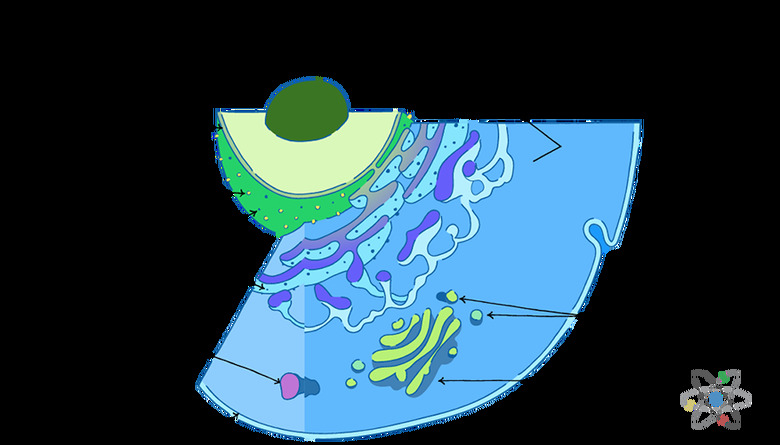Lysosome: Definition, Structure & Function
Lysosomes are small cell organelles in nucleus-bearing or eukaryotic cells.
They are located in the cytosol of the cells, floating freely within the cells outside the nucleus. They have a simple structure made up of an outer lysosomal membrane surrounding an acidic interior fluid.
Lysosomes are like small cell stomachs: they digest waste and superfluous cell fragments.
Lysosome Function
Lysosome Function
The main function of lysosomes is to help with cell metabolism by ingesting and dissolving unwanted parts of the cell, cell debris or foreign substances that have entered the cell.
The digestive enzymes of their acidic interior break down large structures and molecules into simple components, and they then return the products to the cell for further use or disposal.
The lysosomal enzymes are synthesized in the endoplasmic reticulum.
The enzymes are passed on to the Golgi apparatus where the lysosomes are produced. The lysosomes use the acid hydrolases from the endoplasmic reticulum to digest complex proteins and organelles that are no longer needed.
The lysosomes essentially act as the cell's digestive system.
The Structure of Lysosomes
The Structure of Lysosomes
Lysosomes are round membrane-bound organelles with a single outer lysosomal membrane.
The membrane is impervious to the acidic contents of the lysosome. This protects the rest of the cell from the digestive enzymes inside the membrane. Once the acidic pH is established, the lysosome can digest cell waste products, old cell parts and other debris.
To ensure that cell fragments, foreign objects and cell debris are digested while healthy parts of the cell are not attacked, the redundant components are tagged with specific chemicals that identify them as targets.
The lysosome ingests or surrounds the targets and uses some of the hydrolytic enzymes and other chemicals inside the membrane to dismantle complex chemical structures and create simple substances the cell can re-use.
Why Lysosomes Are Important
Why Lysosomes Are Important
Cell biology includes internal processes that produce waste, and other foreign bodies or substances may intrude into the cell.
A cell has to be able to dispose of such unwanted material, and that's the function of the lysosomes. They travel throughout the cell interior and look for material that has been marked as superfluous.
The acidic interior of the lysosome can break down molecules such as complex carbohydrates, large proteins and lipids.
The resulting simple molecules can either be expelled from the cell or used for repair and maintenance of cell structures such as the outer plasma membrane. The products of the lysosomes, when expelled from the cell and transported to other cells, can signal what processes the cell is carrying out and allow other cells to react accordingly.
Why Are Lysosomes Acidic?
Why Are Lysosomes Acidic?
The acidic nature of the fluid inside the lysosome serves two purposes.
First, the acids help with digesting and dismembering the complex molecules of the redundant cell fragments. Second, the digestive enzymes and other chemicals breaking up the lysosome targets are designed to work in an acidic environment. This feature protects the cell.
Should the lysosome rupture or leak, the acidic fluid is rapidly neutralized, and the lysosomal enzymes and other digesting chemicals will no longer be effective and will not attack healthy cell structures.
Maintaining the acidic pH inside the lysosome is therefore critical for its function and for cell protection. The lysosome accomplishes this by using chemical reactions with proton pumps on its surface and inside the membrane to transfer hydrogen ions or protons across the membrane and into the interior.
The hydrogen ions maintain the acidity of the interior fluid.
Role in Disease
Role in Disease
Lysosomes play a role in both the fight against diseases and in the cause of disease. When foreign pathogens such as bacteria enter a cell, the lysosomes can help neutralize them by digesting them. In this way they help with an organism's immune response.
When lysosomes don't work properly, they can cause disorders called lysosomal storage diseases.
If one of the many lysosomal enzymes has an incorrect chemical formula due to a genetic mutation, the substance that the enzyme is supposed to digest builds up. Such disorders can also be linked to cancer and cardiovascular disease.
Normally, lysosomes are an essential part of the cell waste-disposal system, but when one or more enzymes are missing, a fast diagnosis is necessary to replace the enzymes and reduce the waste build-up.
Related concepts and cellular components: > > * PH5 > * Fatty aids > * Cell membrane > * Animal cells > * Golgi apparatus > * Nucleic acids
Cite This Article
MLA
Markgraf, Bert. "Lysosome: Definition, Structure & Function" sciencing.com, https://www.sciencing.com/lysosome-definition-structure-function-13717289/. 15 March 2019.
APA
Markgraf, Bert. (2019, March 15). Lysosome: Definition, Structure & Function. sciencing.com. Retrieved from https://www.sciencing.com/lysosome-definition-structure-function-13717289/
Chicago
Markgraf, Bert. Lysosome: Definition, Structure & Function last modified March 24, 2022. https://www.sciencing.com/lysosome-definition-structure-function-13717289/

